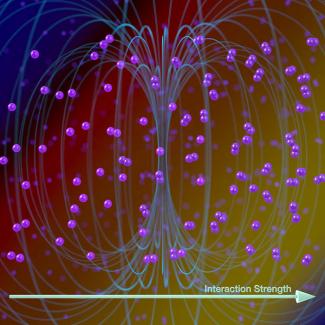A grand challenge of ultracold physics is figuring out how fermions become bosons. This is an important question because the tiniest quantum particles of matter are all fermions. However, these fermions can form larger chunks of matter, such as atoms and molecules, which can be either fermions or bosons.
An interesting feature of fermions and bosons is that they behave very differently at ultracold temperatures. Fermions prefer to go it alone while bosons tend to hang out together. To learn more about the quantum processes that cause quantum particles to change their character so much, the Jin group investigated what happens to potassium atoms that are fermions when they become attracted to each other in an ultracold gas. The group included former research associate Yoav Sagi (Technion Israel Institute of Technology), newly minted Ph.D. Tara Drake, graduate students Rabin Paudel and Roman Chapurin as well as Fellow Deborah Jin.
In the experiment, the researchers found that as they increased the attractions between the potassium atoms (fermions), atom pairs appeared that acted like bosons. The researchers also discovered an intriguing crossover, with fermions on one side and bosons on the other side. But in the crossover, the atoms behaved both like fermions and bosons. Since atoms and molecules can either be fermions or bosons, the Jin group’s goal was to learn more about what happens in the crossover that changes fermions into bosons.
The bosons and fermions in this experiment were quantum particles with quite different behaviors at ultracold temperatures. Independent-minded fermions like the potassium atoms in this experiment never occupy the same quantum state because the laws of quantum mechanics don’t allow it. At zero temperature, fermions occupy energy levels in a ladder-like fashion, with one fermion per energy state. In contrast, copycat bosons like the pairs of potassium atoms in this experiment can fall into the same low-energy state at zero temperature, forming a superatom, or Bose-Einstein condensate.
The trick to making the Jin group’s experiment work was getting the potassium atoms to be strongly attracted to each other, which is something potassium atoms don’t normally feel. Sagi and his colleagues encouraged them by making small changes in the magnetic field around a Feshbach resonance. A Feshbach resonance is a special magnetic field strength where small changes have dramatic effects on the interactions of atoms in an ultracold gas. With these interactions turned on, the individualistic potassium atoms started to act more like bosons.
However, the transition from fermions to bosons didn’t happen right away as happens at zero temperature, where even weak attractions immediately cause potassium atoms to pair up. In this experiment, even when the interactions between atoms were moderately strong, the atoms didn’t form pairs at all. Instead they formed a Fermi liquid.
A Fermi liquid is like a single atom trying to make its way through a crowded party of atoms. As the atom moves along, other atoms stop to interact with it, slowing its progress. However, the self-reliant atom simply isn’t drawn to any other atom strongly enough to form a pair, so it just keeps on moving along.
But, as the night goes on and the strength of the interactions increases, the atom eventually finds a partner to hang out with. And, when all of the potassium atoms find partners, the Fermi liquid disappears, leaving behind a gas of paired potassium atoms, which act like bosons.
However, since an ultracold gas isn’t actually a party, there is still a lot more to learn about the details of how fermions become bosons. Understanding this process may shed light on superconductivity, a process that occurs when electrons (which are fermions) carry electricity with no losses.––Julie Phillips




